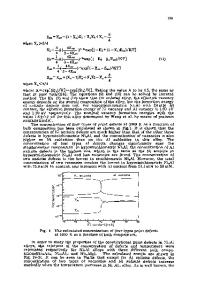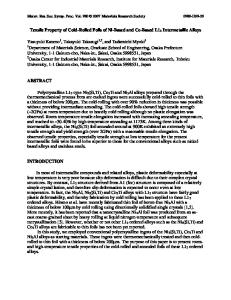{111} Zig-Zag Transgranular Cracking in the L1 2 Intermetallic Compound Ni 3 Ge
- PDF / 2,843,093 Bytes
- 6 Pages / 420.48 x 639 pts Page_size
- 69 Downloads / 440 Views
{111} ZIG-ZAG TRANSGRANULAR CRACKING IN THE L1 2 INTERMETALLIC COMPOUND Ni 3 Ge Jianxin Fang and Erland M. Schulson Thayer School of Engineering, Dartmouth College, Hanover, NH 03755 ABSTRACT Slip and fracture behavior in Ni 3 Ge with and without 0.06 at.% Boron has been examined by in-situ straining in a TEM. Crack propagate in a zig-zag, transgranular manner and the crack planes are coincident with the slip planes. Slip is activated on two major systems and a transition occurs ahead of dislocation pile-ups which occur on the primary system. Due to the thinning of material from the motion of dislocations, the crack follows alternately on these two slip planes, giving rise to the zig-zag transgranular path. Calculations show that the stress field due to the pile-up drives the slip transition. 1. INTRODUCTION Direct observations by transmission electron microscopy have been extensively made of the formation of zig-zag cracks, which are typical rupture modes in various ductile disordered metals and alloys [1-5]. It was found that the edges of the cracks are alternately parallel to and , and that the zig-zag cracks are formed by intense slip along and mechanical twinning parallel to [2, 4, 6, 7]. Recently, zig-zag cracks have been observed in the TEM by in-situ straining the L12 intermetallic compound Ni 3AI [8] and by ex-situ straining of thin films of the L12 alloy Ni 3Ge at atmospheric conditions [9]. In contrast to the fracture morphology in the disordered materials, the traces of the crack surfaces are along in these L12 alloys. It has been suggested [8, 9] that the zig-zag pattern arises from the facts that the crack propagation follows slip bands within which the foils thin due to the slip of dislocations, and that the slip switches from one system to another. However, no attempt to identify the controlling factor for the slip switching has been made yet. In the present work, direct observations were made through TEM in-situ straining of the slip and fracture behavior in polycrystalline thin films of the L1 2 intermetallic compound Ni 3Ge with and without 0.06 at.% boron. The purpose of the work was to determine the factor controlling the slip system transition and, hence, to highlight the mechanism for the formation of the zig-zag transgranular cracks. In this paper, we briefly report the main results obtained. The complete analysis can be found elsewhere [10]. II. EXPERIMENTAL Miniature tensile samples for the in-situ deformation experiments were cut from extruded rods of Ni-23.5 at.% Ge with 0.06 at.% boron and without boron. The processing to produce the rods and the analyzed chemical compositions were described earlier [11]. The geometry of the samples was designed to ensure that deformation and fracture occur within the thin area [8]. The specimens were annealed at 1223 K for 2 hours in an atmosphere of flowing dried and de-oxygenated argon to produce a grain size about 15 aIrm.The samples were electropolished in a modified specimen holder to produce a center hole surrounded by a uniformly thin area. The
Data Loading...











